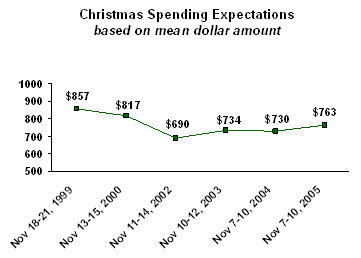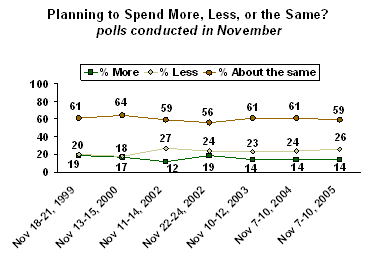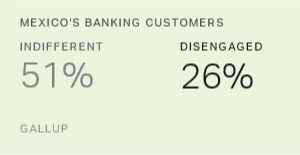GALLUP NEWS SERVICE
PRINCETON, NJ -- Much of the discussion in recent months about the nation's economy has focused on the critical holiday spending season. Roughly a quarter of annual retail sales in the United States are accounted for in the Christmas time period. Analysts, this year in particular, have been speculating about the long-term impact of Hurricane Katrina and the late summer/early fall run up in gas prices on spending this year, and hoping that the season does not turn out to be a disappointment.
There are many factors that help determine retail holiday spending levels -- including consumers' desires for new or exciting products, the degree to which retailers discount their products and run sales, the weather, and the scope of retail advertising. One critical piece of the puzzle is the mental state of consumers. Positive, upbeat, economically content consumers are presumed to be more likely to spend money than are depressed, worried, and concerned consumers.
Gallup has for years tracked consumers' holiday spending intentions by asking a simple question at about this time of year: "Roughly how much money do you think you personally will spend on Christmas gifts this year?" The answers to the question this year suggest that 2005 holiday sales will not lag far behind previous years', and that this holiday season may even see a higher than usual increase in spending for this period.
Spending Plans at Slightly Higher Level Than Mid-November 2004
The Gallup survey, conducted Nov. 7-10, finds that 30% of adults nationwide say they will spend $1,000 or more on gifts, while 26% plan to spend between $500 and $1,000, and 32% plan to spend less than $500. The average is $763.
The most relevant comparison for spending intentions comes from past data collected in mid-November each year. Not surprisingly, Christmas spending expectations were much higher at this time in 1999, when Americans were in the middle of the economic expansion and dot-com boom. At that point, Americans said they planned to spend, on average, $857 on gifts. Over the next three years, average Christmas spending intentions steadily declined, to $817 in 2000, $794 in 2001, and $690 in 2002. In 2003, the average moved up a little to $734, and stayed roughly the same -- at $730 -- last year. This year, the average of $763 is modestly higher than last year and the highest measured since November 2000.

Americans' spending intentions generally change as the holiday season progresses; estimates obtained in December are higher than those measured in November. Last year, for example, Americans' spending estimates rose from $730 in mid-November to $862 in mid-December. Gallup will continue to measure these spending projections in the weeks ahead to see if the same pattern occurs this year.

Fourteen percent of Americans say they will spend more than last year, while 26% say they will spend less, and 59% say they will spend about the same amount. These seemingly more negative attitudes are not unusual. For some reason, Americans have been saying that they are going to spend less for holiday gifts in the current year compared to the previous years for as long as Gallup has been asking the question.
In fact, this year's results on this question show essentially no change from those obtained last year at this time. The net-spending intentions figure this year (percentage who says they will spend more minus the percentage who says they will spend less) is -12. In 2004, the net-spending intentions figure was -10 points, and in 2003 it was -9 points.

Younger vs. Older Americans
The results show a significant change in spending plans among younger Americans (those aged 18 to 29) and older Americans (those aged 65 and older). Younger adults will be spending significantly more than last year, while older Americans will be spending significantly less.
The sample sizes involved in these age groups are relatively small, which means that the margin of error for any year's estimate of spending in these groups is relatively high. Still, this year's changes among younger and older age groups are substantial:
- The current results show a significant increase in the amount of money that 18- to 29-year-olds plan to spend on Christmas gifts this year. On average, younger Americans plan to spend $713 on gifts, up from $548 last November.
- As has been the case in previous years, Americans aged 30 to 49 plan to spend more money on gifts than people in any other age group. Their average predicted expenditure for this year is $872, up from $817 in 2004. The most likely explanation for this finding is the higher incidence of children in the households of those within this age group. There has also been a modest increase in projected spending among this group compared to last year.
- Spending plans among those aged 50 to 64 show a gain compared to last year, from an average of $743 last year to $825 in the latest survey.
- Older Americans have significantly lowered their estimate of holiday spending compared to last year. Those aged 65 and older now plan to spend an average of $512 on gifts, down substantially from $726 last November. There has been quite a bit of year-to-year change in reported spending plans among those in this age group, so it is difficult to say if the current change represents a trend or simply a one-year aberration.
|
Average Amount of Money Spent on Christmas Presents by Age |
|||
|
Mid-November 2004 |
Mid-November 2005 |
|
|
|
18- to 29-year-olds |
$548 |
$713 |
+$165 |
|
30- to 49-year-olds |
$817 |
$872 |
+$55 |
|
50- to 64-year-olds |
$743 |
$825 |
+$82 |
|
65 years and older |
$726 |
$512 |
-$214 |
High Income vs. Low Income Households
It is not surprising to find -- as has always been the case in Gallup's tracking of this spending intention question -- that higher income households plan to spend much more on gifts than lower income households. The following table gives stark evidence for the value of high-end retailers who appeal to upscale households; the average spending is nearly three times that of low-income households.
There has been an increase in projected spending across all three income groups used in this analysis compared to last year.
- Spending intentions increased by $59 over the past year among adults earning $75,000 a year or more, from an average of $1,107 in 2004 to $1,166 this year.
- People earning between $30,000 and $75,000 a year plan to spend an average of $769 on gifts this year, up $37 from last year.
- Americans living in households with annual incomes of less than $30,000 plan to spend an average of $371 on Christmas gifts this year, up only $10 from last year.
|
Average Amount of Money Spent on Christmas Presents by Income |
|||
|
Mid-November 2004 |
Mid-November 2005 |
Change |
|
|
$75,000 a year or more |
$1,107 |
$1,166 |
+$59 |
|
$30,000-$74,999 |
$732 |
$769 |
+$37 |
|
Less than $30,000 a year |
$361 |
$371 |
+$10 |
The Gender Divide
Historically, men have reported higher levels of spending on Christmas gifts than have women. This pattern continues today, as men, on average, plan to spend $851 on Christmas gifts, while women plan to spend $682. Since last year's survey, the amount that men plan to spend has increased, while there has been no change in the projected spending of women.
|
Average Amount of Money Spent on Christmas Presents by Gender |
|||
|
Mid-November 2004 |
Mid-November 2005 |
|
|
|
Men |
$784 |
$851 |
+$67 |
|
Women |
$682 |
$682 |
0 |
Survey Methods
These results are based on telephone interviews with a randomly selected national sample of 1,011 adults, aged 18 and older, conducted Nov. 7-10, 2005. For results based on this sample, one can say with 95% confidence that the maximum error attributable to sampling and other random effects is ±3 percentage points. In addition to sampling error, question wording and practical difficulties in conducting surveys can introduce error or bias into the findings of public opinion polls.
47. Roughly how much money do you think you personally will spend on Christmas gifts this year?
|
$1,000 or more |
|
|
|
Under $100 |
No opinion ^ |
|
Mean (w/ zero) |
Mean (w/o zero) |
|
|
% |
% |
% |
% |
% |
% |
$ |
$ |
$ |
|
|
2005 Nov 7-10 |
30 |
26 |
13 |
16 |
3 |
12 |
500 |
763 |
816 |
|
^ NOTE: Includes those who say they do not celebrate Christmas or do not plan to spend any money on Christmas gifts. |
|||||||||
Trends for Comparison
|
$1,000 or more |
|
|
|
|
No opinion |
|
Mean (w/ zero) |
Mean (w/o zero) |
|
|
% |
% |
% |
% |
% |
% |
$ |
$ |
$ |
|
|
2003 Nov 10-12 |
30 |
25 |
18 |
14 |
3 |
10 |
500 |
734 |
773 |
|
2002 Nov 11-14 |
25 |
27 |
18 |
14 |
3 |
13 |
500 |
690 |
743 |
|
2001 Nov 26-27 |
32 |
30 |
15 |
13 |
2 |
9 |
500 |
794 |
820 |
|
2000 Nov 13-15 |
33 |
28 |
15 |
13 |
2 |
9 |
500 |
817 |
847 |
|
1999 Nov 18-21 |
35 |
27 |
14 |
13 |
6 |
5 |
500 |
857 |
893 |
Full Trend
|
$1,000 or more |
|
|
|
|
No opinion |
|
Mean (w/ zero) |
Mean (w/o zero) |
|
|
% |
% |
% |
% |
% |
% |
$ |
$ |
$ |
|
|
2003 Dec 11-14 |
31 |
28 |
18 |
13 |
3 |
7 |
500 |
776 |
794 |
|
2003 Nov 10-12 |
30 |
25 |
18 |
14 |
3 |
10 |
500 |
734 |
773 |
|
2002 Nov 22-24 |
30 |
30 |
15 |
15 |
3 |
7 |
500 |
753 |
769 |
|
2002 Nov 11-14 |
25 |
27 |
18 |
14 |
3 |
13 |
500 |
690 |
743 |
|
2002 Oct 14-17 |
25 |
26 |
16 |
14 |
2 |
17 |
500 |
695 |
745 |
|
2001 Nov 26-27 |
32 |
30 |
15 |
13 |
2 |
9 |
500 |
794 |
820 |
|
2000 Nov 13-15 |
33 |
28 |
15 |
13 |
2 |
9 |
500 |
817 |
847 |
|
1999 Nov 18-21 |
35 |
27 |
14 |
13 |
6 |
5 |
500 |
857 |
893 |
|
1998 Dec 4-6 |
24 |
25 |
22 |
14 |
8 |
7 |
-- |
-- |
-- |
|
1994 Dec 2-5 |
22 |
20 |
23 |
19 |
9 |
7 |
-- |
-- |
-- |
|
1993 Dec 4-6 |
19 |
27 |
20 |
17 |
8 |
9 |
-- |
-- |
-- |
|
1992 Dec 12-18 |
19 |
24 |
20 |
18 |
10 |
9 |
-- |
-- |
-- |
|
1991 Dec 12-15 |
20 |
24 |
22 |
19 |
7 |
8 |
-- |
-- |
-- |
|
1990 Nov 29-Dec 2 |
17 |
25 |
23 |
19 |
7 |
9 |
-- |
-- |
-- |
|
1989 Oct 12-15 |
18 |
23 |
25 |
15 |
4 |
15 |
-- |
-- |
-- |
48. Is that more, less, or about the same amount as you spend last Christmas?
|
|
|
About |
No |
|
|
% |
% |
% |
% |
|
|
2005 Nov 7-10 |
14 |
26 |
59 |
1 |
|
2004 Nov 7-10 |
14 |
24 |
61 |
1 |
|
2003 Dec 11-14 |
19 |
21 |
58 |
2 |
|
2003 Nov 10-12 |
14 |
23 |
61 |
2 |
|
2002 Nov 22-24 |
19 |
24 |
56 |
1 |
|
2002 Nov 11-14 |
12 |
27 |
59 |
2 |
|
2002 Oct 14-17 |
12 |
22 |
64 |
2 |
|
2000 Nov 13-15 |
17 |
18 |
64 |
1 |
|
1999 Nov 18-21 |
19 |
20 |
61 |
* |
|
1998 Dec 4-6 |
19 |
21 |
60 |
* |
|
1994 Dec 2-5 |
18 |
20 |
62 |
0 |
|
1993 Dec 4-6 |
20 |
27 |
53 |
* |
|
1992 Dec 18-20 |
22 |
28 |
50 |
* |
|
1991 Dec 12-15 |
16 |
33 |
43 |
8 |
|
1990 Nov 29-Dec 2 |
15 |
26 |
57 |
2 |
|
* Less than 0.5% |
||||
